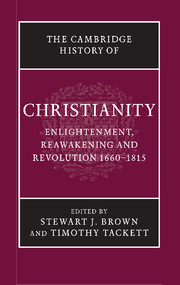Book contents
- Frontmatter
- Introduction
- PART I CHURCH, STATE, AND SOCIETY IN THE EUROPEAN WORLD, 1660–1780
- PART II CHRISTIAN LIFE IN THE EUROPEAN WORLD, 1660–1780
- PART III MOVEMENTS AND CHALLENGES
- PART IV CHRISTIAN DEVELOPMENTS IN THE NON-EUROPEAN WORLD
- 19 Christianity in Iberian America
- 20 British and French North America to 1765
- 21 Christianity in Africa
- 22 Christianity in south and south-east Asia
- 23 Christianity in East Asia
- 24 Christian encounters with other world religions
- PART V REVOLUTION AND THE CHRISTIAN WORLD
- Chronology
- Bibliography
- Index
- References
23 - Christianity in East Asia
from PART IV - CHRISTIAN DEVELOPMENTS IN THE NON-EUROPEAN WORLD
Published online by Cambridge University Press: 28 March 2008
- Frontmatter
- Introduction
- PART I CHURCH, STATE, AND SOCIETY IN THE EUROPEAN WORLD, 1660–1780
- PART II CHRISTIAN LIFE IN THE EUROPEAN WORLD, 1660–1780
- PART III MOVEMENTS AND CHALLENGES
- PART IV CHRISTIAN DEVELOPMENTS IN THE NON-EUROPEAN WORLD
- 19 Christianity in Iberian America
- 20 British and French North America to 1765
- 21 Christianity in Africa
- 22 Christianity in south and south-east Asia
- 23 Christianity in East Asia
- 24 Christian encounters with other world religions
- PART V REVOLUTION AND THE CHRISTIAN WORLD
- Chronology
- Bibliography
- Index
- References
Summary
The mid-seventeenth century was, generally speaking, not a good time for Christianity in East Asia. China was taking a long time to recover from the upheavals of internal rebellion and conquest by the alien Manchus. In Tokugawa Japan, Christianity had been all but eliminated and in Korea it was still virtually unknown. Only in the Philippines had the Catholic Church established a relatively stable presence.
The Philippines: A Catholic enclave in East Asia
The conversion of the Philippines constitutes a remarkable chapter in the history of Christianity in East Asia. By the mid-seventeenth century, only two or three generations after the Spanish conquest, most of the principal islands in the archipelago, except for the Muslim-controlled regions of Mindanao and the uplands of northern Luzon, had become permanently Christian. The Philippines thus formed an early Catholic enclave within the larger non-Christian world of Asia.
Crucial to the spiritual conquest of the Philippineswere the friar missionaries who had arrived with the early Spanish colonizers. In addition to the friars, the Jesuits also played a part in the rapid conversion of the Philippines. It should be noted that the religious institutes in the Philippines received their personnel almost entirely from Spain and to a lesser extent Mexico. In time each of the orders established a Philippine province under a provincial superior based in Manila. The Philippine provinces of the friars comprised not only the territories under their care in the archipelago but also their respective missions on the Asian mainland.
- Type
- Chapter
- Information
- The Cambridge History of Christianity , pp. 451 - 474Publisher: Cambridge University PressPrint publication year: 2006

